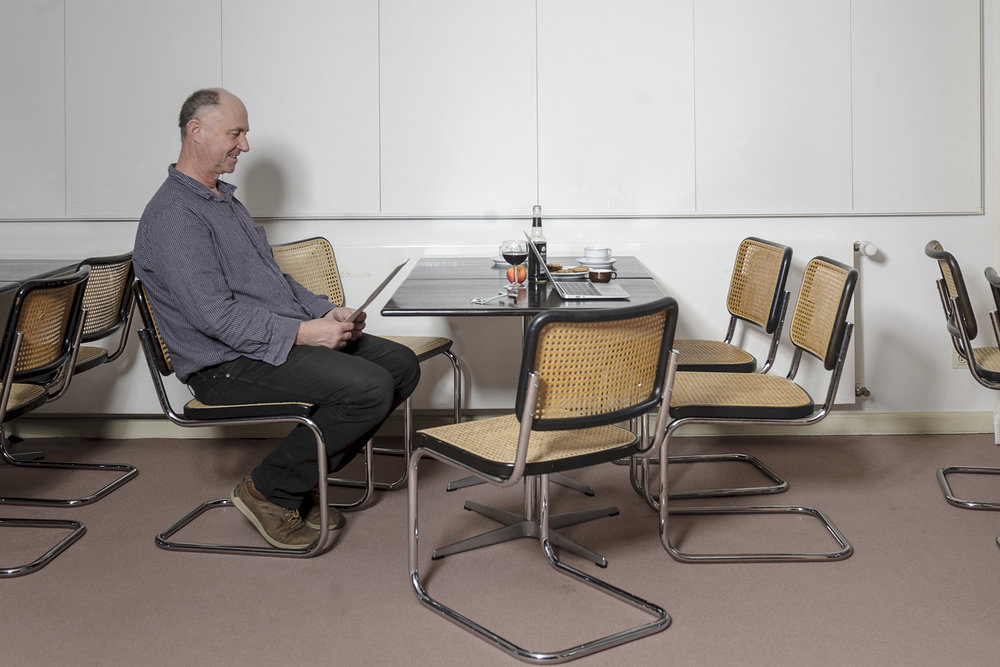Issue 12 / January 2017
Putting the Kakapo on a Diet
a portrait of Michael Jennions, Peter M. Kappeler, Tamás Székely, Steven R. Beissinger by Manuela Lenzen
A Focus Group investigates the Significance of Sex Ratios
Along with the kiwi, the kakapo is one of those strange flightless birds which was able to develop in New Zealand when no mammals were present, but is now an acutely endangered species. Animal-protection advocates strive to fortify the kakapo population through breeding programs, yet the kakapo hens don’t make it easy for them since, when in captivity, they mainly produce sons. By contrast, in fig wasps males are the rarer sex. The females lay their eggs in the inflorescence of tiny flowers inside a fig so that the offspring later develop protected inside the fruit. Most of these eggs hatch as females. There are sometimes only just enough males to fertilize the females. But what are the implications of one sex being rarer?
“It was ultimately the peculiarities of the breeding behavior of many animal species that impelled me to become a biologist,” says Tamás Székely, a professor of biodiversity at the University of Bath, and convener of the Wissenschaftskolleg’s Focus Group Causes and Implications of Adult Sex Ratio Variation in Vertebrates. In biology things do indeed become less straightforward the more one investigates – especially when it comes to differences between the sexes – whether these be in physiological endowments, courtship rituals or parental roles in the rearing of offspring. “There are species where the males look after the offspring and the females hash out the pecking order, but why is this the sex role-allocation in only one percent of species and not the other way around?” asks Székely. Researchers have been in search of explanations for this phenomenon ever since Darwin. “Most scientists, myself included, have examined the environments of these species, along with their life cycles, looking for clues,” continues Székely, “and there are ten different theories that seek to explain the rarity of this breeding system – but none of them works.” Except the one looking at the adult sex ratio, which is at the intellectual core of the Focus Group. “I shouldn’t like to exaggerate the point right now, but the adult sex ratio is a variable that – at least in some types of animals – can explain 60 percent of the variation in sex roles, which is immense,” attests Székely. “And we want to see how far we get with using it in other types of animals.”
When the Focus Group discusses sex ratios the first topic of concern is numbers. How many males are there in relation to females, and why? As early as in 1930 the British geneticist and evolutionary theorist Ronald A. Fisher postulated that sex ratios at birth must be somewhere in the neighborhood of 1:1. This rule of thumb still holds today – although fig wasps are not the sole species where a single male will fertilize numerous females. So why in nature is this not the case in general – that just a few males inseminate a great many more females? “It’s not as simple as all that,” says Michael Jennions, who teaches evolutionary biology at the Australian National University in Canberra, “because evolution doesn’t necessarily provide what’s best for the group. Natural selection usually favors what’s best for the reproductive success of an individual.” He elaborates: If there are more females in a certain population, then the mothers that have genes that make them more likely to produce sons will have more grandchildren and thus these kinds of genes will rise in frequency in the population – so the percentage of mothers who tend to give birth to more sons will increase – until too many males are then competing for too few females. Therefore the sex ratios among most species are more or less equal, at least at birth.
“The parental influence is over once progeny set off into the world,” states Székely. Before the animals are fully grown and themselves seek out breeding partners, there can be a wholesale shift in the sex ratio by dint of living conditions, illnesses, competition and sheer happenstance. And distorted adult sex ratios have consequences for both humans and animals, says Székely: “The ratio of sexually mature males to females in a population has a vast impact on social behavior – namely the choice of partner, care of offspring, economic decisions, divorce rates, the spread of diseases, the frequency of extramarital affairs, and violence against women.” There is evidence for such impact in a wide range of studies. The Focus Group has taken on the task of analyzing and systematizing them, while placing this extremely heterogenous research field on a new basis.
The Focus Group’s own makeup constitutes a bias sex ratio of 4:0 – which the male members seek to offset through their multiplicity of approaches. Székely has researched birds, but at the Wissenschaftskolleg he is investigating the breeding behavior of frogs and focusing on a comparison among various species. Peter Kappeler, a sociobiologist and anthropologist from Göttingen, conducts research on primates. He follows the movements of lemurs in the jungles of Madagascar using electronic tracking devices, and studies their mating behavior, the size of their groups as well as the utility of and costs entailed in the presence of subordinate males. He is also interested in the effects of the sex ratio on the sexual division of time and labor when it comes to raising young. According to the current general theory, the rarer sex should emerge as the more aggressive of the two and concern itself with competition and ranking-order fights, whereas the rearing of offspring falls to the sex in greater abundance. “It’s just that with mammals this theory can’t possibly work because only the females give birth and nurse,” states Kappeler. So he has decided to examine the data on adult sex ratios and their impact on other types of behaviors: “The second step will be similar to what Tamás is doing – comparing a number of primate species.”
Steven R. Beissinger who teaches ecology and conservation biology in Berkeley employs nest boxes instead of high tech tracking devices. The South American green-rumped parrotlet he studies typically reproduce high in the trees. But, on a farm in Venezuela, Beissinger and his team attached sawed-off plastic pipes to fenceposts, which would seem to fulfil the domestic tastes of these small green parrotlets. Over eight thousand of them have since participated in his apartment-building project, while starting over three thousand families. Beissinger could thereby conduct an extensive long-term study of these birds’ breeding behavior. “I’m interested in how assumptions regarding the causes of sex ratios go together with assumptions regarding their impact,” he says, adding that many of his analytical tools were developed in observing “his” parrots, whose adult sex ratios have varied from 60:40 to 70:30 in favor of males over the years. The foreseeable result is pronounced competition among males for the relatively fewer females. “I want to understand how the males decide things – for example, if they take over someone else’s nest, when precisely do they adopt stepchildren and when do they kill them.”
Michael Jennions is concerned with mathematical modelling of the evolutionary process. “We all secretly hope that we can simply give him our findings and he’ll make a consistent model from them,” confesses Székely while Jennions imploringly directs his gaze to the high rafters of this old villa and says, “I’m not a mathematician, I only work with mathematicians,” but then conceding: “I do like studies that investigate the big picture” – through the use of equations that more or less precisely link together the various factors which influence sex ratios. “Most models which attempt to explain the differences in sex ratios, the division of labor in rearing offspring, and which sex engages in pecking-order battles have all hitherto been based on idealized models, proceeding from broad principles that permit us to deduce certain general things.” But nature is far too rich and variegated for such models. Jennions continues: “It is, in fact, a big problem making the complex diversity of empirical data jibe with the prevailing theories. What can a general theory really predict for a specific, concrete situation? Not easily answered.” It is for this reason that, for starters, he has committed himself to meta-analysis of the data: Theories create suppositions, but how well are they substantiated in nature? And he is regularly confronted with an entertaining, if aggravating, phenomenon, namely the tendency to deem true those explanations which tell a good story. For instance: females who have found an attractive partner should have more sons because the assumption is that these sons will be disproportionately successful at acquiring mates. “A nice textbook story,” says Jennions, “but unfortunately there’s little evidence for it.” And often it is mathematical modeling which can distinguish between the nice story and a plausible explanation. Beissinger: “The last thirty or forty years we have worked on the assumption that the parents’ investment determines future behavior – that is to say, who fights and who rears the offspring. Michael and his colleagues have shown with their models that it can’t be that simple, and now we want to profit from their insights.”
More plausible models are one reason to tackle the complex phenomenon of how sex ratios affect sex roles anew, but another reason is that, in the meantime, there are increased and more reliable studies. “Up until now we have primarily had what the researchers call anecdotal evidence – reports that no one could validate,” explains Székely. This has changed in recent years. Moreover there are now better methods for ascertaining sex, including genetic analyses. According to Beissinger, “With birds it is often difficult to even distinguish between males and females. With new methods this has become both simpler and cheaper.” And researchers have meanwhile achieved greater awareness of the fact that findings with respect to sex ratios can play an important role in the preservation of endangered species. “When the sex ratio is highly distorted,” says Székely, “this often signifies that a population is being threatened.”
If the euphoric mood of the group still sometimes gives way to one of anxiousness this is due to the magnitude of their self-imposed task: “The field is so large,” says Beissinger, “sometimes you have the feeling that you’re making no progress at all.” There is often a lack of suitable comparative data. “When you have a new theory then you sift through the data and see if it can be confirmed or refuted,” explains Kappeler. “But then you realize that there is, say, only population data for one species and behavioral data for another. That’s what makes our project so challenging.” These evolutionary biologists point, however, to a paradox of science in the new age of large databases in other areas of biology such as genomics – namely the fact that in these areas there are not too many theories but rather too few. “We need good theories more urgently than ever,” states Jennions. “Everyone is busy assembling data which we then don’t know what to do with. You also need a good theory so as to know which data you should collect, and then how to analyze it.”
It is apparent that this is not to be accomplished by just four Fellows. In February a workshop will bring together the world’s most important researchers on the topic, including those who are concerned with sex ratios among humans. “That’s a real minefield,” says Kappeler whose focus on primates makes him the researcher with interests that most closely address humans and their sensibilities. “Because it also concerns fundamental questions as to what extent we humans are impacted by those biological forces we share with animals, and the role culture plays. And when it comes to sex roles – the choice of partners, competition and childrearing – then the minefield becomes even more hazardous.” Even within the Focus Group. “As soon as you start dealing with these questions then you are co-opted for a political agenda,” says Székely. “I’m a scientist, I want facts, not an agenda!” Jennions believes this to be an idealized vision of science: “Scientists aren’t robots, they too have biases, but science is quicker to correct them.”
Kappeler has a current example at hand – 70 percent of the refugees who have recently arrived in Germany are young men. Fears were promptly raised that this would lead to greater criminality. An initial empirical study, albeit based on data from the United States, arrived at the opposite finding – that in local populations where men are the majority, the crime rate sinks. And what conclusion should be drawn? “It is unclear whether one can draw conclusions for one country based on data from another,” states Kappeler,” but it is an intriguing result. We can only supply the debate with information.” In any event a mammoth task.
“The best thing would be to have an interdisciplinary consortium with both natural and social scientists,” muses Székely. “We could form small teams that fan out and collect data. And every three months we would meet and see: What have you found? How far advanced is your model? That would be a paradise.” Evolutionary biologists do indeed have a harder time initiating such large-scale projects than, say, those engaged in brain research or genomics. Why? The Fellows’ attempts at explanation range from there being no lobby for such things, to a lack of experience in these cooperative endeavors, and the political undesirability of evolutionary biology in many countries, through to that classic question posed by granting institutions about the practical applicability of one’s findings. “But evolutionary research always means taking a step back to keep your eye on the big picture,” says Kappeler, “this is the basis of the entire discipline.”
The result is often entirely useful findings, and sometimes nice stories prove to be correct. For instance take this one: females instinctively respond to being better nourished by making more sons, which holds the promise of many more offspring due to their greater sexual competitiveness. On a trial basis New Zealand conservationists therefore put their kakapo hens on a strict diet – and, as if by magic, far more female chicks hatched from their eggs. “Here we have evolutionary biology being put to direct use in the cause of species conservation,” says Beissinger, and the others nod – consensus at last!
More on: Michael Jennions Peter M. Kappeler Tamás Székely Steven R. Beissinger
More on: Causes and Implications of Adult Sex Ratio Variation in Vertebrates
Images: © Maurice Weiss








